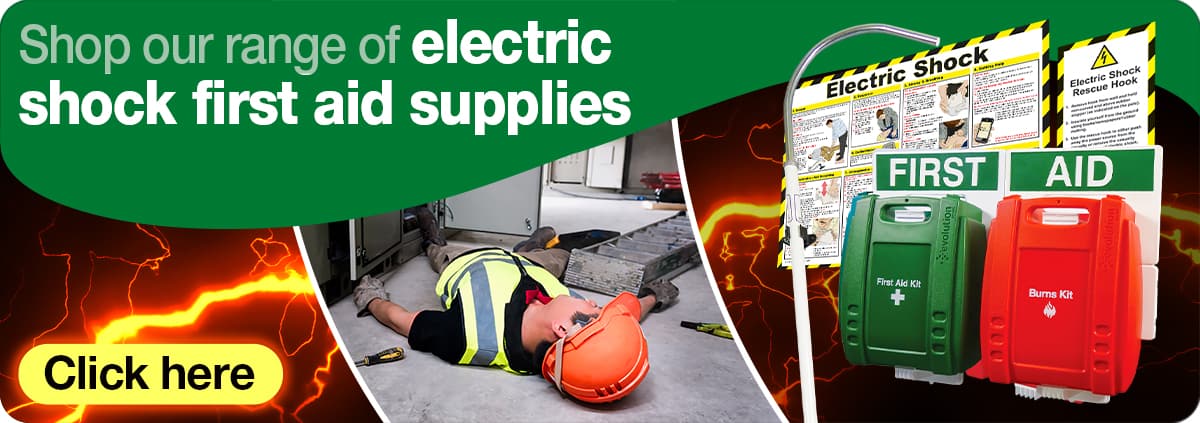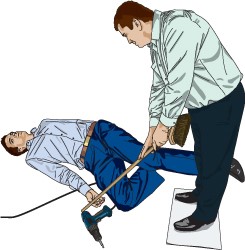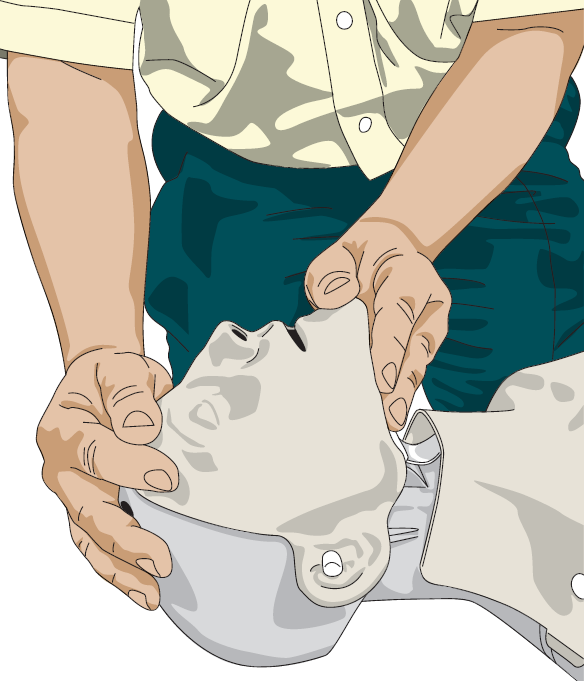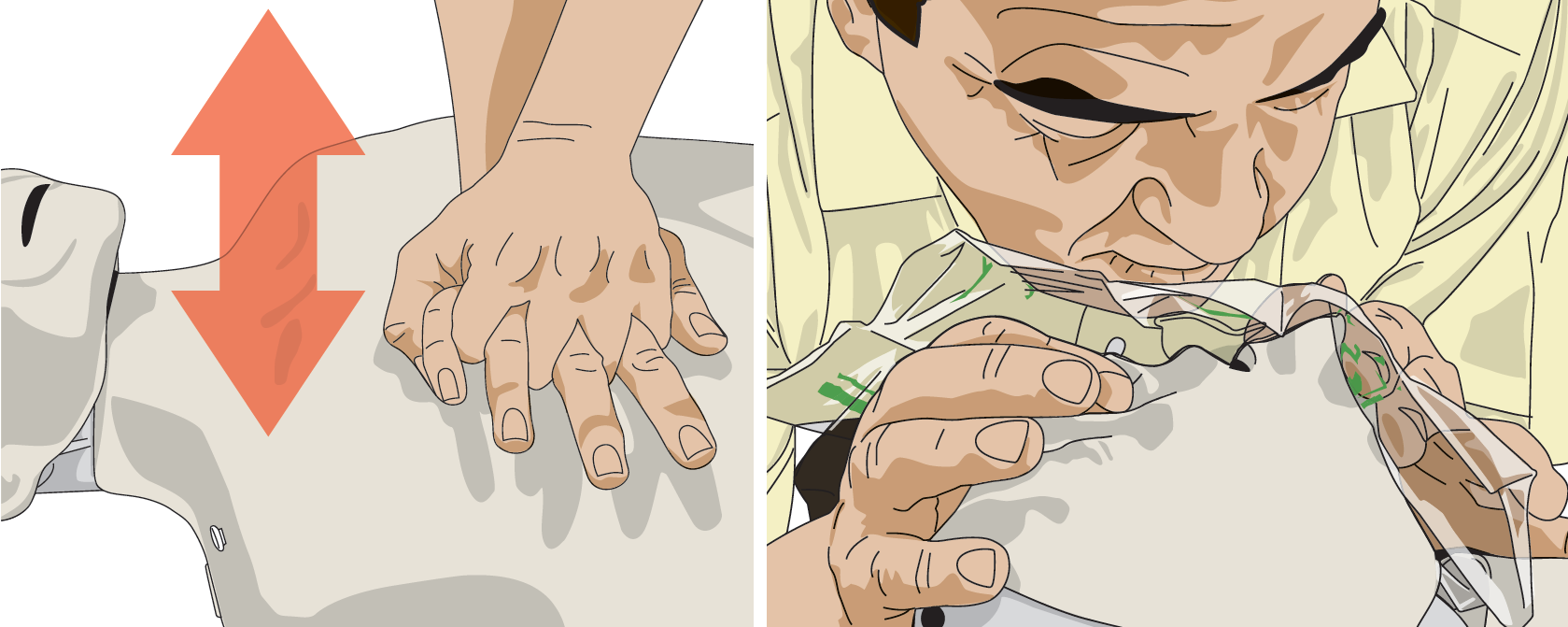
Important Electric Shock Information
1) Danger
If you suspect someone has received an electric shock you must ensure all power sources are isolated before you can treat the casualty. The action you take will depend on whether the risk is posed by high voltage or low voltage electricity.High Voltage
Overhead power cables are an example of a power source generating high voltage electricity. High voltage electricity has the ability to 'jump' or 'arc' up to distances of 18 metres or more. If faced with a casualty as a result of, or in the vicinity of, dangerous high voltage electricity, DO NOT APPROACH! Stay at least 25 metres away from the casualty until the power has been switched off by an official agency i.e. the Electricity Board.
Low Voltage
If faced with a casualty who is in the process of receiving a low voltage electric shock you should:
- Act to break the contact between the casualty and the electrical supply. If possible to do so safely, you should turn off the source of electricity, either by switching off the current at the mains, turning the power off at the circuit board, removing the plug or wrenching the cable free.
- Alternatively, move the source of the shock (i.e. hairdryer, power tool) away from yourself and the casualty using an object of low conductivity. First, stand on a dry insulating material, such as a book, newspapers or rubber matting. Then, use a long, low-conductivity object like a wooden broom or specially designed Electric Shock Rescue Hook to push the power source away from the casualty or move the casualty's limbs away from the power source.

2) Response
To give your casualty the optimum chance of survival you must quickly assess their levels of response. A rapid assessment will allow effective treatment to be administered and will also allow for accurate information to be passed on to the ambulance service. DO NOT touch the casualty if you have been unable to isolate them from the source of the electrical shock or turn off the electricity.- Check whether the casualty is concious:
2. Ask in both the casualty's ears for them to open their eyes.
3. Pinch an ear lobe or tap the shoulders.
4. Shout for HELP!
5. DO NOT move the casualty unless the environment or situation is dangerous.
If the casualty is responsive, call emergency services now.
3) Unresponsive casualty
Your first priority is to open the casualty's airway and check for breathing. Open the airway by lifting the chin and tilting the head back. This will free the tongue from the back of the throat. If you are unable to open the casualty's airway in their current position, roll them onto their back. Check the mouth for any obvious instructions.
Then, check for breathing as follows:
1. LOOK for the rise and fall of the chest.
2. LISTEN for the sounds of breathing.
3. FEEL for air on your cheek
4. Carry this out for up to 10 seconds
If the casualty is breathing, put them into the recovery position (see section 6) and then call 999 for emergency help. Continually monitor and record vital signs - breathing, pulse and responsiveness - until help arrives.
If the casualty is not breathing normally:
1. Ask a helper to call 999 for an ambulance and then to bring an AED if available. If you are alone, make the call yourself.
2. Begin CPR with chest compressions as soon as possible. Do not leave the casualty to search for an AED.
When phoning emergency services, DO NOT hang up at any stage of the conversation. The operator will terminate the call when appropriate. You should determine responsiveness and whether the casualty is breathing before speaking to the emergency services because this enables them to assign the appropriate priority to your situation.
4) Unresponsive and not breathing normally - giving CPR
1. Ensure the casualty is lying on their back on a firm, flat surface2. Place your hands one on top of the other in the centre of the casualty's chest
3. Compress the chest (up to a maximum depth of approximately 4-5cm) 30 times at a rate of 100-120 compressions per minute. The compressions and releases should take an equal amount of time
4. After 30 compressions, open the airway again using the head tilt/chin lift
5. Seal the nostrils with your thumb and forefinger
6. Blow steadily into the mouth until you see the chest rise. This should take about a second. If available, it is advisable you use resuscitation equipment, such as a face shield.
7. Remove your mouth to the side and let the chest fall. Inhale some fresh air and repeat these steps so you have given 2 effective rescue breaths in total.
8. If the chest does not rise after the second breath, go back to 30 compressions and then try again with 2 breaths.
9. Return your hands to the correct position on the chest and give a 30 chest compressions.

Continue giving CPR at a ratio of 30 compressions followed by 2 rescue breaths until:
- The casualty shows signs of recovery
- Emergency services arrive
- The situation changes and you are now in immediate danger
5) Defibrillation
If an AED is available, power on the device and follow the prompts.6) Unresponsive and breathing - the recovery position
If the casualty is unresponsive and breathing normally, turn the casualty to the recovery position. This allows the head to be tilted back and down, stopping the tongue from blocking the airway and allowing any vomit or fluid to drain safely from the mouth.1. Check for any other obvious injuries
2. Remove sharp objects from casualty's pockets
3. Turn the casualty into the recovery position as follows:
4. Place the nearest arm at a right angle to the body
5. Draw the furthest arm across the chest and place the back of the hand across the cheek nearest to you
6. Keep this here whilst you raise the furthest leg by grasping the top of the knee
7. Gently pull on the knee so the casualty pivots over onto their side facing you
8. The casualty should be fully onto their side and stable
9. Adjust the upper leg so the hip and the knee are bent at right angles
10. Re-check the airway, breathing and circulation. Ensure the airway is open
11. Check for continued breathing
12. Ask someone to call 999 if not done already. If you are alone, do so yourself. Leave the casualty if necessary but return as soon as possible.
Click here for a NHS video on the recovery position.

7) Burns
Exposure to electricity can cause burns to the skin, and in severe cases, the internal organs. The electricity may cause 'entry' and 'exit' burns - for example, entering via a hand and leaving via the feet.For responsive casualties:
- Cool burns for a minimum of 10 minutes under cold water
- Cool the burn with wet dressings (or special burn dressings) after placing them in the recovery position.
- Burst any blisters
- Apply adhesive dressings
- Remove damaged skin
- Apply ointments/creams
- Cover with 'fluffy' dressings
- Affix dressings too tightly
- Apply butter/fats/margarine or other substances commonly believed to cool burns
- Remove damaged clothing
- Apply ice
8) Other injuries
Muscle spasms/seizures: These may be present for some time after the exposure to electricity and indicate a seriously ill casualty.Action in the event of a major seizure:
1. If standing, the casualty will almost definitely collapse during a major seizure. Try to control the fall.
2. Ensure the safety of the casualty by removing any objects that may cause injury if struck.
3. Place padding under the head. Improvise if necessary with clothing.
4. DO NOT place anything inside the casualty's mouth
5. Loosen any clothing that may restrict the airway
6. Try to time the seizure
When the seizure has subsided:
1. Check the casualty's responsiveness and Airway, Breathing and Circulation (ABC)
2. If unresponsive and breathing normally or semi-concious, place the casualty in the recovery position. Continue to monitor ABC and other injuries
3. If unresponsive and not breathing, perform CPR
Casualties with no apparent injury:
If no injury is present and the casualty appears well, it is still advisable to take the casualty to a hospital or medical facility for a check-up, as certain organs/systems within the body may be affected several hours after a shock.
Find out more
An electric shock guidance poster is available to buy, helping to raise safety awareness throughout your organisation. The Electric Shock poster has clear, step by step instructions on how to react in case of an electric shock and how to provide treatment to someone that has been electrocuted. The poster is designed for both first aiders and non-first aiders providing them with the essential first aid and safety information.Electric shock first aid and rescue products
Shop our range of electric shock first aid supplies to assist with the rescue and first aid treatment of someone who has received an electric shock.This article is not intended as a substitute for first aid training.
By Sophie
Explore more:
